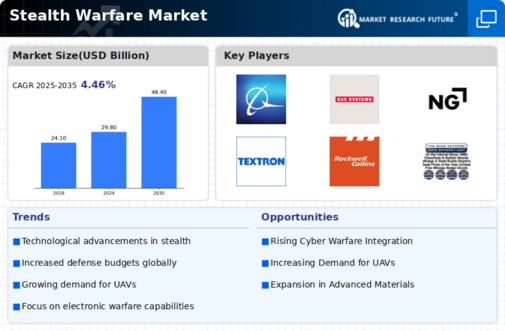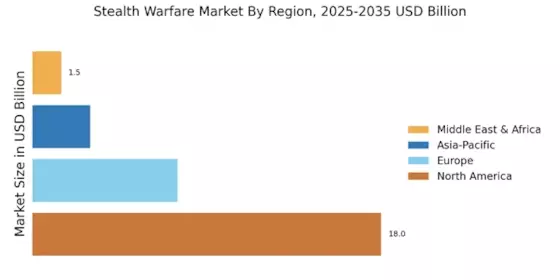Defense Modernization Programs
The Stealth Warfare Market is benefiting from extensive defense modernization programs being implemented by various nations. Governments are recognizing the necessity of upgrading their military capabilities to address evolving security challenges. These modernization initiatives often prioritize the development and acquisition of stealth technologies, as they are crucial for maintaining strategic advantages. For instance, countries such as India and Japan have announced substantial investments in next-generation stealth aircraft and naval vessels, with budgets exceeding 10 billion dollars over the next decade. This trend indicates a commitment to enhancing national defense through advanced stealth systems. Furthermore, as nations seek to replace aging fleets and improve operational readiness, the demand for innovative stealth solutions is likely to increase, further propelling growth within the Stealth Warfare Market.
Increased Geopolitical Tensions
The Stealth Warfare Market is significantly influenced by rising geopolitical tensions across various regions. Nations are increasingly investing in stealth capabilities to counter perceived threats and enhance their deterrence strategies. For example, the ongoing territorial disputes in the South China Sea and the resurgence of military posturing in Eastern Europe have prompted countries to bolster their defense budgets. Reports indicate that defense spending in these regions has increased by an average of 5% annually, with a substantial portion allocated to stealth technology development. This trend suggests that as tensions escalate, the demand for advanced stealth systems will likely grow, driving innovation and competition within the Stealth Warfare Market. Additionally, the need for covert operations and intelligence gathering further underscores the importance of stealth capabilities in modern warfare.
Emerging Threats and Asymmetric Warfare
The Stealth Warfare Market is increasingly shaped by the emergence of new threats and the evolution of asymmetric warfare. Non-state actors and insurgent groups are employing unconventional tactics that necessitate advanced stealth capabilities for effective countermeasures. As these threats become more sophisticated, traditional military forces are compelled to adapt their strategies, leading to a heightened focus on stealth technologies. Reports suggest that defense budgets are increasingly allocating resources to develop systems capable of countering these asymmetric threats, with an estimated 15% of military spending directed towards stealth capabilities. This shift indicates a recognition of the need for stealth in modern conflict scenarios, thereby driving growth within the Stealth Warfare Market. The ability to conduct operations undetected is becoming paramount, as militaries seek to maintain an edge over adversaries employing unconventional tactics.
Technological Advancements in Stealth Warfare Systems
The Stealth Warfare Market is experiencing a notable surge due to rapid technological advancements in stealth systems. Innovations in radar-absorbing materials and low-observable technologies are enhancing the capabilities of military aircraft and naval vessels. For instance, the development of advanced composite materials has improved the radar cross-section of stealth platforms, making them less detectable. According to recent data, investments in stealth technology are projected to reach approximately 30 billion dollars by 2026, reflecting a growing emphasis on maintaining air superiority. Furthermore, the integration of next-generation sensors and electronic warfare systems is likely to redefine operational strategies, thereby driving demand within the Stealth Warfare Market. As nations prioritize modernization of their defense capabilities, the focus on stealth technology is expected to intensify, leading to increased competition among defense contractors.
Integration of Artificial Intelligence in Stealth Operations
The integration of artificial intelligence (AI) into stealth operations is emerging as a pivotal driver within the Stealth Warfare Market. AI technologies are being utilized to enhance decision-making processes, improve target recognition, and optimize mission planning. For instance, AI algorithms can analyze vast amounts of data from various sensors, enabling stealth platforms to operate more effectively in contested environments. The market for AI in defense is projected to grow at a compound annual growth rate of over 20% through 2027, indicating a robust interest in leveraging AI for stealth applications. This integration not only enhances operational efficiency but also reduces the risk to personnel and assets, thereby making stealth systems more attractive to military planners. As AI continues to evolve, its role in the Stealth Warfare Market is expected to expand, potentially revolutionizing how stealth operations are conducted.


















Leave a Comment